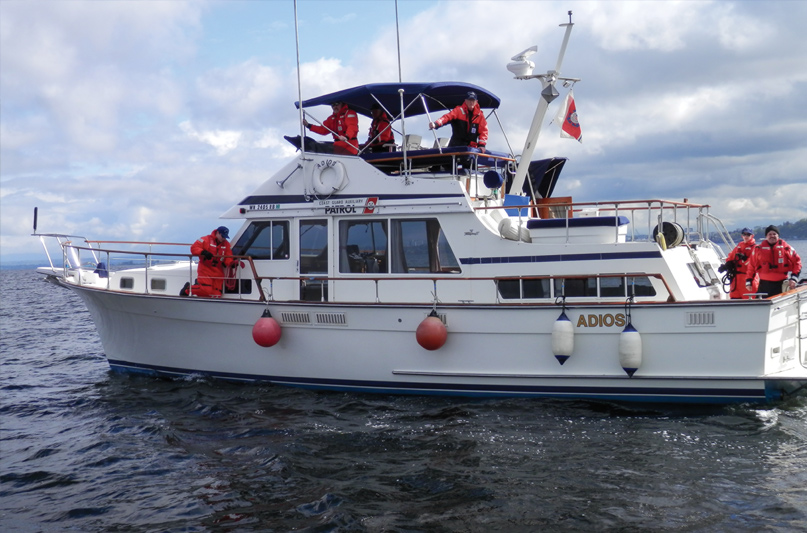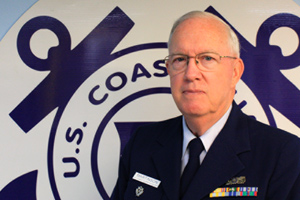“Semper Paratus.”
-Latin phrase meaning “Always Ready” and official motto of the U.S. Coast Guard Auxiliary
 Silver and orange Coast Guard boats are a common sight on waters all over the U.S. as they carry out their role as a rescue and police service all rolled into one.
Silver and orange Coast Guard boats are a common sight on waters all over the U.S. as they carry out their role as a rescue and police service all rolled into one.
They’re a small branch of the military with just about 41,000 active service personnel responsible for thousands of miles of coastline and both poles of the globe. The U.S. Coast Guard covers a lot of ocean, but the Coast Guard Reserve and the Coast Guard Auxiliary are aiding them in their mission and lending a helping hand anywhere they can.
Many boaters who don’t know much about the Coast Guard Auxiliary, and even those who have, might think the Auxiliary is comprised of retired Coast Guard members who teach classes on the weekends. However, the purpose and the history of the Auxiliary is much deeper, and the Auxiliary has more to offer than many boaters realize.
This month, we sit down with Richard Martinson (Coast Guard Commander, Ret.) of the Edmonds Coast Guard Auxiliary Flotilla 12 to get a better idea of what the Auxiliary is all about, what services it provides to the recreational boating community, and the surprising ways that the typical boater can serve in the organization.
NWY: Can you tell us a little about the Coast Guard Auxiliary? How did it get started and what was its original mission?
The Auxiliary got started in 1939. It’s interesting that even during the Great Depression, people were still buying motorboats. Suddenly there were more of these boats on the water than there ever had been, and along with that came a big increase in accidents, some quite serious, and they were grabbing headlines.
This got the attention of Congress, and they decided that we needed to start educating people so they could operate their boats safely.
Congress decided maybe the Coast Guard was the best agency to take that on; 1939 was an interesting year for the Coast Guard. Firstly, the Coast Guard didn’t exist under the banner of ‘Coast Guard’ until 1915.
Before that, the Revenue Cutter Service and the U.S. Life-Saving Service were separate entities that were then melded together under the name Coast Guard, and then in 1939, the Bureau of Lighthouses and the Bureau of Marine Inspection and Navigations were also added to the Coast Guard.
So, all of a sudden the Coast Guard had two rather significant missions added to their duties, and the Auxiliary was formed, all in the same year. The Auxiliary was originally called the United States Coast Guard Reserve, and it was thought of as a reserve, with a bunch of volunteers serving as a backup to help the active duty members, which is what the Auxiliary started as and still is— an organization made up of volunteers.
Auxiliary members are not in the military nor are they law enforcement. It’s an organization of civilian volunteers who help support the missions of the active duty Coast Guard. Anyone can join without obligation, and then leave whenever they want to. We have no ranks, no ‘yes sir, no sir’, no saluting. Even though the Auxiliary has no law enforcement or military functions today, at the beginning, one of its functions was to enforce the law and ensure compliance, which I think is pretty interesting.
But the basic thing that the Coast Guard wanted the Auxiliary to do was, number one, educate people, second, offer safety inspections, and third, operate safety patrols— in other words increasing the amount of Coast Guard on the water and ashore keeping things safe.
By WWII, the Coast Guard figured it would probably need a military reserve of active service members, so the Coast Guard Reserve as we know it today was created, and the original Reserve had its name changed to the Auxiliary.
NWY: So, the Auxiliary was created with the purpose of education and maintaining safety on the water from the beginning? It wasn’t related to the start of WWII and possible US involvement?
No, its original purpose was always public education and assisting the Coast Guard in boating safety.
But many Auxiliary members were involved with the war effort. When the US entered the war, and the Coast Guard needed a lot of people and equipment — they looked to the Auxiliary for that kind of support.
To make this happen, the Coast Guard formed the Temporary Reserve with Auxiliarists as the nucleus. As Temporary Reservists, the Auxiliary were given uniforms and told they could serve wherever they currently lived, but were not allowed to volunteer more than three days a week.
The reason for that was because many of these people were eligible for regular service in the military during the war, but they were in professions and jobs that were deemed important for the war effort and were thus exempt from the draft.
So, the Auxiliary grew pretty significantly during the war. Members of the Auxiliary were even made officers and given command of search and rescue stations, small boat stations, port security units, things like that, which is interesting because those are full-time jobs, and they were trying to get it done with just three days a week.
They gave all their free time to the Temporary Reserve, wore uniforms, served as officers and issued orders, all while not getting paid a thing. At the end of the war, they reversed back to the Auxiliary we know today.
NWY: Can you tell us how you got involved in the Auxiliary?
Well I’ve been involved in some part of the greater maritime world since 1960. I’ve held a Merchant Marine masters license continuously since 1966, and along the way, besides working in the merchant marine and doing things there, I served four years in the Navy, and a total of 24 in the Coast Guard, and ultimately retired from there, so I have a nautical background if you will, and I joined the Auxiliary the first time in 1965 at 17 years old.
Earlier when I said I’ve been in the maritime world since 1960, I mean I got started as a crew member on a charter boat when I was 12 years old.
In 1965, a friend and I took the Basic Skills and Seamanship course the Auxiliary puts on and saw a lot of guys that seemed pretty sharp putting on the course, and we asked them how you joined the Auxiliary. They told us we had to be 17 and had to have our own boat.
We were 17 but didn’t have a boat, so we bought a 20’ gill-net skiff for $20, and we got a 10hp outboard from my dad, and that worked to get us in the Auxiliary.
In those days, you had to have either a boat, and airplane, or a ham radio. You had to have one of those three and in joining offer it to the Coast Guard should they require its use. That’s not the case today, but that’s how it was then.
I was a member of the Auxiliary for 13 years, and then active duty Coast Guard got in the way, so I went into a status they had back then known as ‘member at large’, and then fast forward to 2014, when I retired from everything I was doing, and I guess my wife wanted me to get out of the house more, and she suggested re-joining the Auxiliary (laughs).
NWY: So how does the Auxiliary continue its mission of public safety and education for boaters?
The first thing we do are the courtesy vessel safety inspections. This is where you as a private boater can ask the Auxiliary to check your boat out, and see if it meets the basic federal safety requirements. We’ll come aboard for free, and see if you meet the requirements and if you don’t, there are no consequences from us. We won’t give you a ticket or anything else.
Now for the active duty Coast Guard on the other hand, if they’ve boarded you and find you’re not in compliance with the regulations, they can give you a ticket. The Auxiliary can’t give you a ticket. And remember, the Coast Guard has a right to board your boat anytime they want. They don’t need probable cause.
In fact, it gets rather interesting when you have a lawyer with a boat telling a Coast Guard crew that ‘You can’t board my boat, you don’t have probable cause’ and the Coast Guard says, ‘Well, we don’t need probable cause,’ and then they find his stash of marijuana.
The Auxiliary will just point out where you’re lacking and tell you what to do to fix it. But if you pass, the Auxiliary will give you a sticker for your boat’s window, and hypothetically a Coast Guard patrol will see that you’ve passed an inspection from the Auxiliary and leave you alone, unless you have a clear violation out in the open they can see.
The stickers are shaped like a shield and have the Coast Guard logo on it and the year it was issued. They are good for one year, and then you need to get inspected again.
When I was on active duty in the Coast Guard, and I specifically instructed my crews that unless you see a violation, leave the boat alone. So, it might be worth having the inspection from the Auxiliary to avoid getting a ticket from the Coast Guard, and getting the sticker might also save you from the hassle of a boarding from a Coast Guard crew.
NWY: So how does a vessel examination work? Can you walk us through the process and what to expect?
Well, my flotilla in the summertime, on weekends, has a desk at the Port of Edmonds, so there will be someone there you can walk up to and ask to come check your boat. You can also call your local Auxiliary flotilla and have someone come down to your boat and have them take a look.
They’ll be checking for the minimum federal requirements for a boat. And it’s possible that beyond that, they might see something else like some wiring that’s beginning to go, and they can point it out to you. And there’s no penalty for missing the requirements.
You could have none of the requirements fulfilled and the Auxiliary will just tell you, you need to correct this.
Part II of this story will continue next month, so stay tuned!
